[English] 日本語
 Yorodumi
Yorodumi- EMDB-21607: Internal translation of large subunit transcripts drives synthesi... -
+ Open data
Open data
- Basic information
Basic information
| Entry | Database: EMDB / ID: EMD-21607 | |||||||||
|---|---|---|---|---|---|---|---|---|---|---|
| Title | Internal translation of large subunit transcripts drives synthesis of small subunits in type I CRISPR-Cas Cascade | |||||||||
 Map data Map data | Type I-D Cascade from Synechocystis with crRNA bound. | |||||||||
 Sample Sample |
| |||||||||
| Biological species |  | |||||||||
| Method | single particle reconstruction / negative staining / Resolution: 19.0 Å | |||||||||
 Authors Authors | McBride TM / Schwartz EA / Kumar A / Taylor DW / Fineran PC / Fagerlund RD | |||||||||
 Citation Citation |  Journal: Mol Cell / Year: 2020 Journal: Mol Cell / Year: 2020Title: Diverse CRISPR-Cas Complexes Require Independent Translation of Small and Large Subunits from a Single Gene. Authors: Tess M McBride / Evan A Schwartz / Abhishek Kumar / David W Taylor / Peter C Fineran / Robert D Fagerlund /   Abstract: CRISPR-Cas adaptive immune systems provide prokaryotes with defense against viruses by degradation of specific invading nucleic acids. Despite advances in the biotechnological exploitation of select ...CRISPR-Cas adaptive immune systems provide prokaryotes with defense against viruses by degradation of specific invading nucleic acids. Despite advances in the biotechnological exploitation of select systems, multiple CRISPR-Cas types remain uncharacterized. Here, we investigated the previously uncharacterized type I-D interference complex and revealed that it is a genetic and structural hybrid with similarity to both type I and type III systems. Surprisingly, formation of the functional complex required internal in-frame translation of small subunits from within the large subunit gene. We further show that internal translation to generate small subunits is widespread across diverse type I-D, I-B, and I-C systems, which account for roughly one quarter of CRISPR-Cas systems. Our work reveals the unexpected expansion of protein coding potential from within single cas genes, which has important implications for understanding CRISPR-Cas function and evolution. | |||||||||
| History |
|
- Structure visualization
Structure visualization
| Movie |
 Movie viewer Movie viewer |
|---|---|
| Structure viewer | EM map:  SurfView SurfView Molmil Molmil Jmol/JSmol Jmol/JSmol |
| Supplemental images |
- Downloads & links
Downloads & links
-EMDB archive
| Map data |  emd_21607.map.gz emd_21607.map.gz | 5.6 MB |  EMDB map data format EMDB map data format | |
|---|---|---|---|---|
| Header (meta data) |  emd-21607-v30.xml emd-21607-v30.xml emd-21607.xml emd-21607.xml | 11.2 KB 11.2 KB | Display Display |  EMDB header EMDB header |
| Images |  emd_21607.png emd_21607.png | 24.4 KB | ||
| Archive directory |  http://ftp.pdbj.org/pub/emdb/structures/EMD-21607 http://ftp.pdbj.org/pub/emdb/structures/EMD-21607 ftp://ftp.pdbj.org/pub/emdb/structures/EMD-21607 ftp://ftp.pdbj.org/pub/emdb/structures/EMD-21607 | HTTPS FTP |
-Validation report
| Summary document |  emd_21607_validation.pdf.gz emd_21607_validation.pdf.gz | 297.3 KB | Display |  EMDB validaton report EMDB validaton report |
|---|---|---|---|---|
| Full document |  emd_21607_full_validation.pdf.gz emd_21607_full_validation.pdf.gz | 296.8 KB | Display | |
| Data in XML |  emd_21607_validation.xml.gz emd_21607_validation.xml.gz | 5.7 KB | Display | |
| Arichive directory |  https://ftp.pdbj.org/pub/emdb/validation_reports/EMD-21607 https://ftp.pdbj.org/pub/emdb/validation_reports/EMD-21607 ftp://ftp.pdbj.org/pub/emdb/validation_reports/EMD-21607 ftp://ftp.pdbj.org/pub/emdb/validation_reports/EMD-21607 | HTTPS FTP |
-Related structure data
| Related structure data | C: citing same article ( |
|---|---|
| Similar structure data |
- Links
Links
| EMDB pages |  EMDB (EBI/PDBe) / EMDB (EBI/PDBe) /  EMDataResource EMDataResource |
|---|
- Map
Map
| File |  Download / File: emd_21607.map.gz / Format: CCP4 / Size: 11.4 MB / Type: IMAGE STORED AS FLOATING POINT NUMBER (4 BYTES) Download / File: emd_21607.map.gz / Format: CCP4 / Size: 11.4 MB / Type: IMAGE STORED AS FLOATING POINT NUMBER (4 BYTES) | ||||||||||||||||||||||||||||||||||||||||||||||||||||||||||||||||||||
|---|---|---|---|---|---|---|---|---|---|---|---|---|---|---|---|---|---|---|---|---|---|---|---|---|---|---|---|---|---|---|---|---|---|---|---|---|---|---|---|---|---|---|---|---|---|---|---|---|---|---|---|---|---|---|---|---|---|---|---|---|---|---|---|---|---|---|---|---|---|
| Annotation | Type I-D Cascade from Synechocystis with crRNA bound. | ||||||||||||||||||||||||||||||||||||||||||||||||||||||||||||||||||||
| Projections & slices | Image control
Images are generated by Spider. | ||||||||||||||||||||||||||||||||||||||||||||||||||||||||||||||||||||
| Voxel size | X=Y=Z: 2.61 Å | ||||||||||||||||||||||||||||||||||||||||||||||||||||||||||||||||||||
| Density |
| ||||||||||||||||||||||||||||||||||||||||||||||||||||||||||||||||||||
| Symmetry | Space group: 1 | ||||||||||||||||||||||||||||||||||||||||||||||||||||||||||||||||||||
| Details | EMDB XML:
CCP4 map header:
| ||||||||||||||||||||||||||||||||||||||||||||||||||||||||||||||||||||
-Supplemental data
- Sample components
Sample components
-Entire : Type I-D Cascade
| Entire | Name: Type I-D Cascade |
|---|---|
| Components |
|
-Supramolecule #1: Type I-D Cascade
| Supramolecule | Name: Type I-D Cascade / type: complex / ID: 1 / Parent: 0 |
|---|---|
| Source (natural) | Organism:  |
| Recombinant expression | Organism:  |
| Molecular weight | Experimental: 450 KDa |
-Experimental details
-Structure determination
| Method | negative staining |
|---|---|
 Processing Processing | single particle reconstruction |
| Aggregation state | particle |
- Sample preparation
Sample preparation
| Concentration | 0.045 mg/mL |
|---|---|
| Buffer | pH: 7.5 |
| Staining | Type: NEGATIVE / Material: uranyl acetate |
| Grid | Model: C-flat / Material: COPPER / Mesh: 400 / Support film - Material: CARBON / Support film - topology: CONTINUOUS / Pretreatment - Type: GLOW DISCHARGE |
- Electron microscopy
Electron microscopy
| Microscope | TFS TALOS |
|---|---|
| Image recording | Film or detector model: FEI CETA (4k x 4k) / Digitization - Dimensions - Width: 4096 pixel / Digitization - Dimensions - Height: 4096 pixel / Number grids imaged: 1 / Number real images: 70 / Average exposure time: 1.0 sec. / Average electron dose: 30.0 e/Å2 |
| Electron beam | Acceleration voltage: 200 kV / Electron source:  FIELD EMISSION GUN FIELD EMISSION GUN |
| Electron optics | Illumination mode: FLOOD BEAM / Imaging mode: BRIGHT FIELD / Cs: 2.7 mm / Nominal defocus min: -1.5 µm / Nominal magnification: 57000 |
| Sample stage | Specimen holder model: OTHER |
 Movie
Movie Controller
Controller


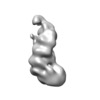

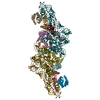
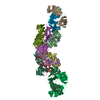


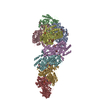

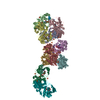
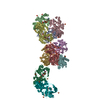
 Z (Sec.)
Z (Sec.) Y (Row.)
Y (Row.) X (Col.)
X (Col.)





















